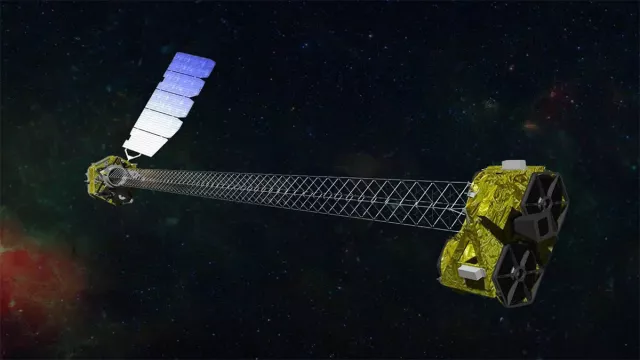In June 2012, NASA’s NuSTAR observatory (Nuclear Spectroscopic Telescope ARray) was deployed in space at the end of its 10-metre mast to sense ‘hard’ X-rays, the most energetic X-rays in the Universe.
Key information
| Mission | Study in fine detail different sources of hard X-rays like supernovae remnants |
|---|---|
| Domain | Science |
| Launch date | 13 June 2012 |
| Partners | NASA (initiator), Technical University of Denmark (DTU), ASI, CNRS |
| Where | Near-circular 600-km orbit |
| Lifetime | Initially 2 years, still working nominally |
| Status | In operation |
Key figures
- 10-m mast
- 350 kg: satellite mass
- 3 to 79 keV: observable X-ray energy range
- 2 detector units
Key milestones
- 2022: NASA extends mission to 2025
- 22 June 2012: NuSTAR’s mast deployed
- 13 June 2012: NuSTAR launched by Pegasus XL
- November 2003: NASA selects NuSTAR mission
- May 2003: NuSTAR project kicks off
Project in brief
NuSTAR is a small NASA space observatory designed to detect hard X-rays emitted by energy sources in the universe like black holes, supernovae and active galaxies. These X-rays are even more energetic than those previously studied by the Chandra and XMM-Newton space telescopes. Operating two telescopes deployed at the end of a mast, NuSTAR is NASA’s 11th Small Explorer (SMEX) mission. It was launched by a Pegasus vehicle in June 2012.
The processes that cause supernova explosions are still only partly understood by astronomers. One of NuSTAR’s missions is to map young remnants of recent supernovae and the distribution of black holes, and to identify the highest-energy sources in our Milky Way Galaxy like supermassive black holes and active galaxies (magnetars).
CNES’s role
NuSTAR is led by the California Institute of Technology (Caltech) and managed by NASA’s Jet Propulsion Laboratory in Pasadena, California. The mission was developed in partnership with the Technical University of Denmark (DTU) and ASI, the Italian space agency. The IRAP astrophysics and planetology research institute helped to calibrate the telescopes’ glass optics with support from CNES.
Contacts
Head of Astronomy & Astrophysics
Philippe Laudet
E-mail: philippe.laudet at cnes.fr


